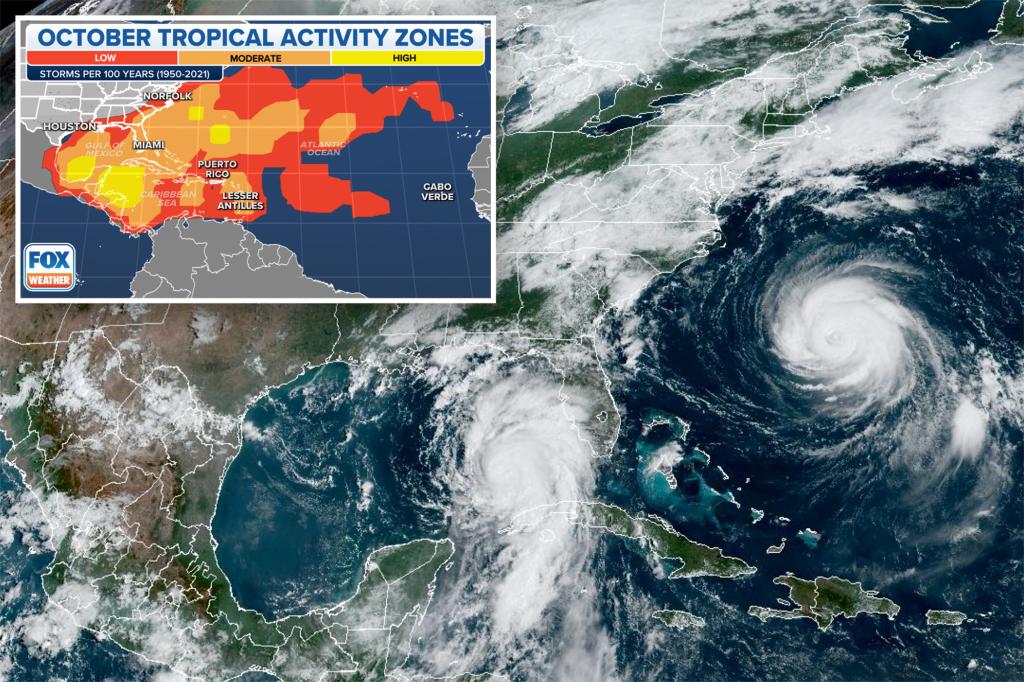Although the climatological peak of the hurricane season – September 10 – was last week, residents living along the East and Gulf coasts of the US should not let themselves off the hook in October.
October ranks as the third most active month (after September and August) for tropical activity in the Atlantic Basin, typically producing about two named storms each year, one of which becomes a hurricane.
And every other October, on average, one of those hurricanes becomes a “major hurricane,” reaching Category 3 intensity or higher on the Saffir-Simpson Hurricane Wind Scale.
While much of the Atlantic Basin remains open for development in October, much of the tropical activity tends to shift westward as the disturbances that often occur in Africa during the peak of the hurricane season begin to fade.
And any disturbance that develops off the coast of Africa in October will often experience hostile atmospheric conditions such as dry air and strong upper-level winds over eastern tropical Atlantic waters.
So, in October, we actually look closer to home for the best opportunities for tropical development.
The western Caribbean Sea, the eastern Gulf of Mexico, and the western and central Atlantic Ocean are the areas where you are most likely to encounter tropical storms or hurricanes in October.
This means parts of the East and Gulf coasts of the US remain at risk of storm landfall.
Map of Hurricane Idalia headed toward Florida on August 29, 2023. According to experts, people on the east coast should not be on the lookout for hurricanes in October even though the peak of the season has passed. NOAA/REUTERS Circulation Houses are damaged by Hurricane Idalia in Horseshoe Beach, Florida.REUTERS/Julio Cesar Chavez/File Photo
Between 1950 and 2022, the US was hit by 20 landfalling hurricanes in October, according to NOAA’s Hurricane Research Division.
Of course, that doesn’t include Superstorm Sandy because the former hurricane lost its tropical characteristics before making landfall near Atlantic City, New Jersey, on Oct. 29. 2012.
Since 2016 alone, five October hurricanes have made landfall in the US, including Matthew (2016), Nate (2017), Michael (2018), Delta (2020) and Zeta (2020). 2021 is the first time since 2018 that the US has not been hit by a hurricane in October.
On average, about a quarter of Atlantic tropical cyclone activity remains from October 3 to the end of the Atlantic hurricane season on November 30. FOX Weather Tropical activity shifts west through October. FOX Weather
More hurricanes have affected South Florida in October than any other month.
Throughout 2021, the October 26 hurricane has passed within 100 nautical miles of Miami since record keeping began in 1851, according to NOAA’s Historic Hurricane Track.
By November, however, the Atlantic is usually calm for the last month of the hurricane season, which ends on November 30.
This map shows where tropical cyclone activity tends to occur in October. The data is shown as a combination of the number of tropical depressions, tropical storms and hurricanes whose centers passed within 125 miles of a point on the map over a 100-year period. The analysis is based on data from a 72-year period from 1950 to 2021 but normalized to 100 years. FOX Weather
NOAA data shows that only five hurricanes ever made landfall in the US in November.
Hurricane Kate in 1985 became the nation’s most recent landfalling hurricane of the season when it made landfall at Category 2 intensity on the evening of November 21 near Mexico Beach, Florida.
Categories: Trending
Source: thtrangdai.edu.vn/en/



